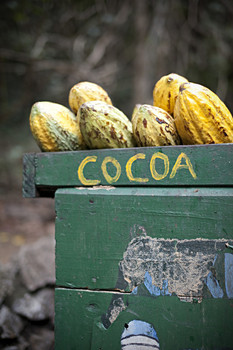Core problem not addressed
“Despite all the efforts in cocoa at the moment, the core of the problem is still not being addressed; the extreme poverty of cocoa farmers, and their lack of a voice in the debate,” said Antonie Fountain, co-author of the Barometer. In that light, the 2015 Cocoa Barometer focuses on value distribution in the supply chain, and on the actual income of cocoa farmers. This is the first time such a study has been conducted. To stimulate discussion on these vital topics, all of the underlying data and research will be made publicly available.
Low income for cocoa farmers
West African cocoa farmers live well below globally defined poverty levels. In Côte d’Ivoire – the world’s largest producer of cocoa – a farmer should earn four times his current income in order to reach the global poverty line of $2 a day. To achieve a level sufficient to cover basic needs (a living income), this would probably need to be a lot higher.
Cocoa not an attractive future
The lack of a decent livelihood for cocoa farmers leads to bad labour circumstances, human rights violations, and many other problems in the cocoa supply chain, including child labour. Cocoa no longer offers an attractive future. Increasingly, younger generations of cocoa farmers are leaving cocoa, and older farmers are nearing the age of life expectancy.
Too much market concentration
An unfair distribution of value and power in the cocoa chain are part of the root causes of extreme poverty for cocoa farmers. Mergers and takeovers have resulted in just a few companies dominating up to 80% of the whole value chain, while farmers lack a sufficiently organised voice to be strong actors. Particularly chocolate manufacturers (such as Mars, Nestlé, Ferrero and Mondelēz), processors (such as Barry Callebaut and Cargill), and retailers gain a lot in comparison to the other stakeholders.
Certified chocolate on the increase
Certified chocolate production continues to increase globally, from 2% reported in the first Barometer in 2009, to almost 16% of global chocolate sales in the 2015 Cocoa Barometer. Most major companies (with the exception of Mondelēz and Nestlé) now have committed to full certification or verification by 2020. However, with the mainstreaming of certification, the challenges of certification are also increasing. Improvements in certification are needed, especially concerning impact on the ground, the quality of auditing, and unrest among farmers about low payments of premiums.
Current approaches won’t solve the problem
While most of the sustainability efforts focus on increasing a farmer’s productivity, this approach alone will not solve the problem. Yields do need to rise, but increasing farmers’ productivity must be coupled with an increased cocoa price for farmers. This means that chocolate needs to become more expensive. Crop diversification, tenure security, better infrastructure and access to information for farmers are also needed.
Shared responsibility
All of the players in the cocoa value chain need to step up to the plate. Companies, governments, retailers, as well as consumers should take their shared responsibility, and truly start looking for new approaches to some of these longstanding problems. Fountain’s conclusion: “Unless the cocoa sector fundamentally changes, there will be no future cocoa farmers.”
Recommendations:
1. Develop a living income model for smallholder cocoa farming.
2. Address the price-setting mechanisms in order to increase prices at farm-gate level.
3. Move from voluntary to mandatory sector-wide solutions.
[1] The Cocoa Barometers are semi-annual overviews of the state of sustainability of the cocoa sector, and are published by a European consortium of civil society actors; FNV Mondiaal (NL), Hivos (NL), Solidaridad (NL) and the VOICE Network – ABVV/Horval (BE), Berne Declaration (CH), FNV (NL), Oxfam Novib (NL), Oxfam Wereldwinkels (BE), Stop the Traffik (UK), and the Südwind Institut (GE).

